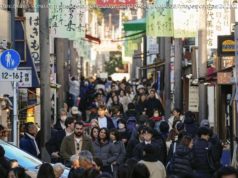A university’s orders to remove a Tiananmen Square monument show how deep Beijing’s Hong Kong crackdown goes.
Each spring, activists in Hong Kong wash the “Pillar of Shame” as part of the city’s annual commemoration of the Tiananmen Square massacre. This coming year, there may not be anything left to cleanse. The University of Hong Kong demanded the removal of the Pillar of Shame, a sculpture that memorializes the pro-democracy demonstrators killed in the Chinese government’s crackdown on June 4, 1989. The statue, created by Danish artist Jens Galschiøt, was installed on the campus nearly 25 years ago. Now, the university has threatened to “deal with the Sculpture at such time and in such manner as it thinks fit without further notice,” according to a letter that the law firm representing the university, the US-based Mayer Brown, sent to the now-dissolved group in charge of the statue. This is not just a small squabble over a sculpture, but another sign of the pressure Beijing is exerting over Hong Kong. Hong Kong was one place in China where people could openly honor the victims of the Tiananmen Square massacre and continue the legacy of the student-led pro-democracy movement. In mainland China, especially among the younger generations, the history is practically erased from public consciousness. This is what made Hong Kong’s Tiananmen Square commemorations so powerful. They are a direct challenge to Beijing, and why the Chinese government sees memorials like the Pillar of Shame as a threat. This is about trying to scrub the memories of not just Tiananmen Square but also the pro-democracy activism it continues to inspire. And it is an attempt for the Chinese Community Party to suppress resistance in Hong Kong and bring it closer and closer into Beijing’s orbit until there is little difference with mainland China. The implementation of the sweeping national security law in 2020 has accelerated that process. In particular, the law — and pandemic restrictions, which banned mass gatherings — curtailed Hongkongers’ ability to honor Tiananmen Square, and has put at risk those who organize or participate in such efforts. The Hong Kong Alliance, the group to whom Galschiøt loaned the 26-foot pillar, disbanded in September after its members faced national security charges. The deadline set for the sculpture’s removal passed, and the statue remains in place, for now, though for how long is unclear. ( A typhoon also just walloped Hong Kong.) A spokesperson for the University of Hong Kong said in an emailed statement that HKU is “still seeking legal advice and working with related parties to handle the matter in a legal and reasonable manner.” Galschiøt, the artist, has retained a lawyer; the sculpture still belongs to him. He told Vox that “for the moment, the next few days, it should be safe.” He is not hopeful, however, that the statue will remain. “They will remove it because of pressure from the Chinese government, they are afraid of the Chinese government, and they are afraid of the national security law,” he said. The sculpture, then and now, is about the fight for democracy in Hong Kong The Pillar of Shame was first displayed in 1997 at the candlelight vigil in Hong Kong’s Victoria Park to commemorate Tiananmen Square.






